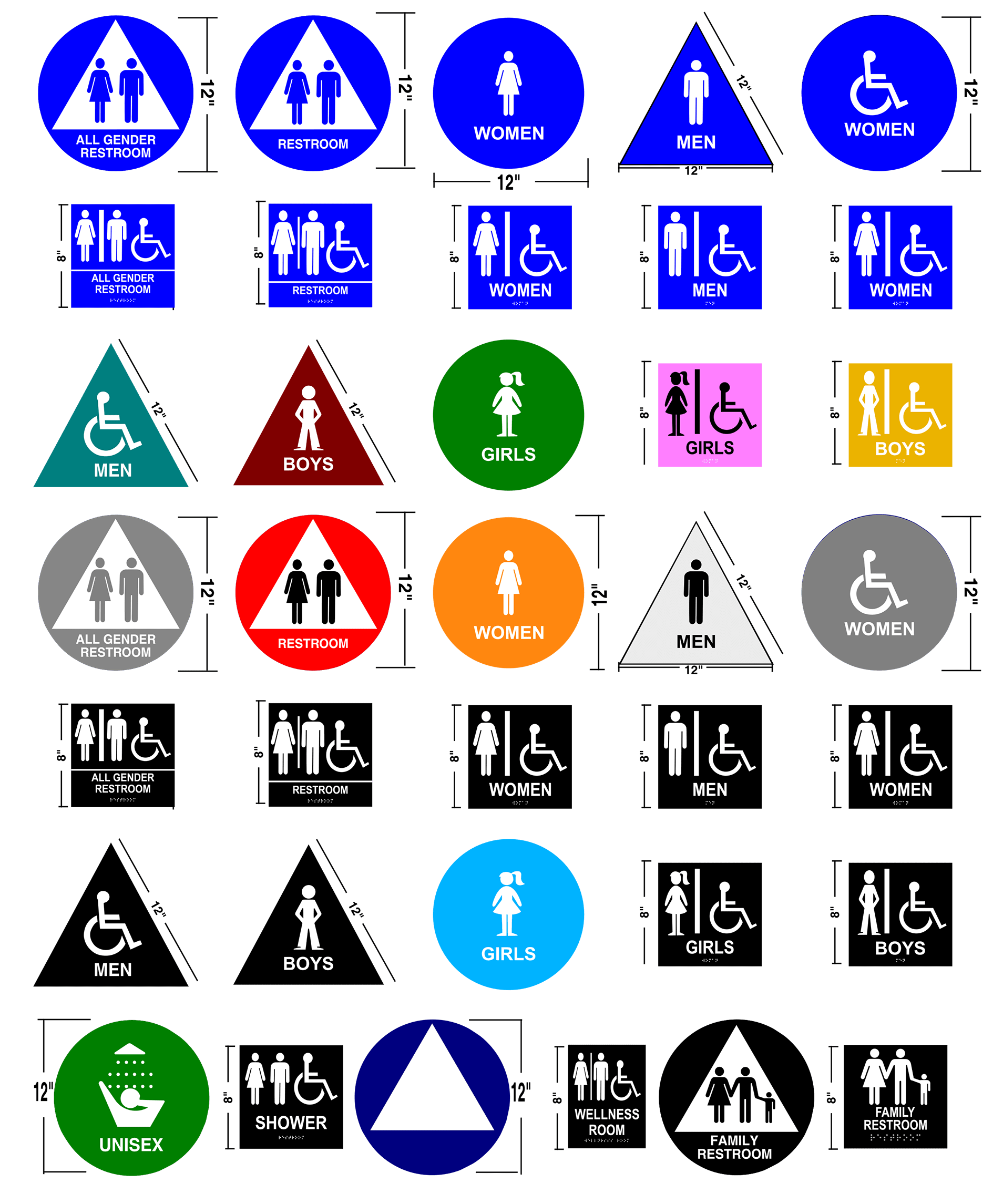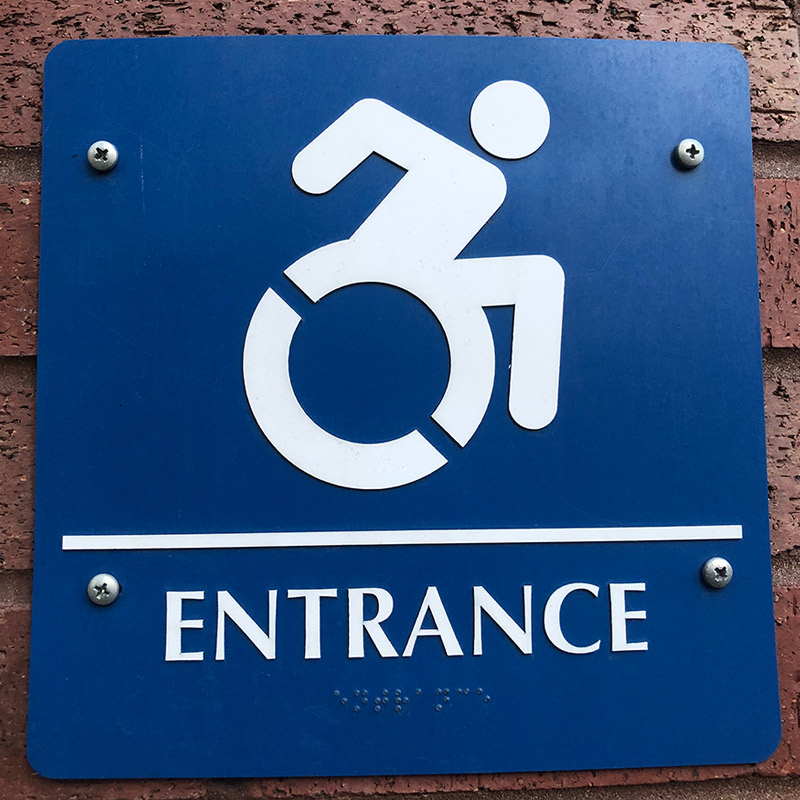Discovering Imaginative Layouts for Effective ADA Signs
Discovering Imaginative Layouts for Effective ADA Signs
Blog Article
Exploring the Secret Attributes of ADA Indications for Improved Access
In the world of accessibility, ADA indicators serve as quiet yet effective allies, ensuring that areas are navigable and inclusive for individuals with handicaps. By incorporating Braille and tactile components, these indicators damage barriers for the aesthetically damaged, while high-contrast shade systems and readable font styles provide to diverse visual needs.
Importance of ADA Conformity
Ensuring compliance with the Americans with Disabilities Act (ADA) is critical for fostering inclusivity and equal accessibility in public rooms and offices. The ADA, passed in 1990, mandates that all public facilities, companies, and transportation solutions suit individuals with disabilities, guaranteeing they delight in the same legal rights and chances as others. Compliance with ADA criteria not only fulfills lawful obligations however also boosts an organization's credibility by demonstrating its commitment to variety and inclusivity.
Among the key elements of ADA compliance is the execution of accessible signs. ADA signs are designed to ensure that people with handicaps can quickly navigate via areas and structures. These indications have to follow certain guidelines relating to size, typeface, color contrast, and placement to assure visibility and readability for all. Appropriately executed ADA signage helps get rid of obstacles that individuals with disabilities commonly come across, therefore advertising their independence and self-confidence (ADA Signs).
In addition, adhering to ADA regulations can alleviate the danger of prospective penalties and lawful effects. Organizations that stop working to follow ADA guidelines may face penalties or suits, which can be both financially troublesome and destructive to their public image. Hence, ADA compliance is integral to fostering a fair setting for everybody.
Braille and Tactile Aspects
The consolidation of Braille and tactile components into ADA signs personifies the concepts of ease of access and inclusivity. It is generally placed underneath the equivalent text on signs to make sure that individuals can access the information without aesthetic assistance.
Responsive aspects extend beyond Braille and consist of elevated signs and personalities. These components are made to be discernible by touch, allowing individuals to determine room numbers, toilets, leaves, and various other crucial areas. The ADA establishes certain guidelines regarding the size, spacing, and placement of these responsive components to maximize readability and guarantee consistency across various settings.

High-Contrast Color Systems
High-contrast color pattern play a crucial role in improving the presence and readability of ADA signs for individuals with aesthetic impairments. These schemes are essential as they take full advantage of the distinction in light reflectance in between message and background, making certain that signs are easily discernible, even from a range. The Americans with Disabilities Act (ADA) mandates the usage of particular shade contrasts to fit those with limited web vision, making it a crucial facet of compliance.
The efficiency of high-contrast colors hinges on their ability to stand out in various illumination problems, consisting of poorly lit settings and locations with glare. Commonly, dark message on a light pop over to these guys history or light text on a dark background is utilized to attain optimum contrast. Black text on a yellow or white background supplies a stark aesthetic distinction that aids in quick recognition and understanding.

Legible Fonts and Text Dimension
When thinking click for info about the layout of ADA signs, the choice of legible fonts and ideal text dimension can not be overemphasized. These components are crucial for making certain that indicators come to people with aesthetic problems. The Americans with Disabilities Act (ADA) mandates that fonts need to be not italic and sans-serif, oblique, script, extremely ornamental, or of unusual form. These needs assist make sure that the text is quickly legible from a distance which the characters are distinct to varied audiences.
The dimension of the message likewise plays a crucial duty in ease of access. According to ADA standards, the minimal text height ought to be 5/8 inch, and it must raise proportionally with watching distance. This is especially important in public rooms where signage needs to be reviewed promptly and accurately. Consistency in message size contributes to a cohesive visual experience, assisting individuals in navigating environments effectively.
Additionally, spacing between lines and letters is integral to readability. Appropriate spacing prevents characters from appearing crowded, boosting readability. By sticking to these standards, developers can significantly boost availability, making certain that signs offers its intended purpose for all individuals, no matter of their aesthetic abilities.
Efficient Placement Techniques
Strategic placement of ADA signage is crucial for making the most of ease of access and ensuring compliance with legal requirements. Appropriately positioned signs guide individuals with impairments properly, promoting navigation in public areas. Key considerations include distance, height, and exposure. ADA standards specify that indications should be installed at a height between 48 to 60 inches from the ground to ensure they are within the line of view for both standing and seated individuals. This conventional elevation variety is critical for inclusivity, enabling wheelchair customers and people of differing elevations to accessibility information effortlessly.
In addition, signs should be placed surrounding to the latch side of doors to permit easy identification before entry. This placement aids people locate rooms and spaces without blockage. In cases where there is no door, signs need to be situated on the nearby surrounding wall. Uniformity in indicator placement throughout a center improves predictability, minimizing confusion and boosting overall user experience.

Verdict
ADA indications play a vital function in promoting availability by integrating functions that resolve the requirements of individuals with specials needs. These aspects collectively foster a comprehensive setting, highlighting the value of ADA conformity in making certain equivalent accessibility for all.
In the world of ease of access, ADA signs serve as silent yet powerful allies, making certain that spaces are accessible and comprehensive for individuals with impairments. The ADA, established in 1990, mandates that all public facilities, employers, and transportation services suit people with disabilities, ensuring they take pleasure in the very same rights and chances as others. ADA Signs. ADA indications are designed to make certain that people with disabilities can easily browse through spaces and buildings. ADA standards specify that indicators must be mounted at an elevation in between 48 to 60 inches from the ground to ensure they are within the line of sight for both standing and seated individuals.ADA indications play a vital role in advertising access by incorporating attributes that deal with the requirements of individuals with impairments
Report this page